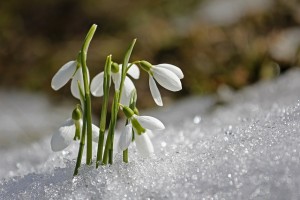 Imbolc asks us to wake up, to pay attention.
Imbolc asks us to wake up, to pay attention.
Imbolc marks the halfway point between the Winter Solstice and the Vernal Equinox and represents the quickening of Mother Earth, when life stirs deep within the land, bringing the promise of spring. Imbolc comes on February 1 this year.
Mother Earth awakens, even as it feels that she will slumber forever. The time of daylight lengthens every day, even when we are unaware. The world quickens toward spring in the darkest time of the year, and we don’t notice. Life renews itself, even when the world is covered in a blanket of snow. Winter drags on, and it feels as if it will never end.
But it will. Spring will come again. Crocuses and daffodils and snowdrops will burst forth. Redbud tree leaves will unfurl. Trickling streams will become raging rivers. One day, without warning, you’ll drive home from work and realize the sun has not yet set.
Celebrated for millennia, there are several possible meanings of the word Imbolc: “in the belly,” referring to the pregnancy of ewes, “ritual cleansing,” “milk,” and “budding.” Imbolc has long been associated with the Goddess Brigid (often pronounced “breed”).
In Celtic lands, Goddess Brigid has been revered, particularly at Imbolc, since ancient times. Perhaps loved more than any other Celtic Goddess, Brigid, a fertility Goddess, is the Goddess of sacred wells, fire, poetry, smithery, milk and early lambs. As Christians overtook paganism, they were unable to take Brigid from the heart of the Celts, and so they made her into Saint Brigid and created the holiday of Candlemas.
Throughout Ireland and other Celtic lands, there are still sacred wells dedicated to Brigid. The waters are said to have healing properties, and are used to bless people, livestock and property. A shrine in Kildare, Leinster, Ireland, is thought to be the oldest that commemorates her, and a perpetual flame is tended there to honor Brigid as Goddess of fire.
Brigid protects the ewes that sometime deliver early lambs at Imbolc, and she is honored as the protector of mothers, particularly pregnant and lactating women.
Because Imbolc is a feast of home and hearth, poems are often read in her honor during quiet evenings around the fire.
Her name is spelled many ways in many lands, and a specially-designed cross made of rushes is her primary symbol, although dolls made of reeds or rushes are also made to honor her. (You can find instructions for making these on the internet.) The crosses are hung above doors and windows in homes and stables to protect them from fire and lightning.
This year, as in years past, my friends and I gather on this joyful holiday to celebrate the stirring of Mother Earth, and to honor Goddess Brigid. We’ll create an altar filled with candles, early spring flowers, metal (to represent smithery), and other symbols of the holiday. We’ll bless each other with sacred water and read poetry. We’ll eat great food, and set aside a plate for Brigid. We will give thanks for the comfort of home and hearth, for the quickening of Mother Earth, and for each other.
Perhaps more than all else, Brigid represents hope. At this cross-quarter time of Imbolc between the faint glimmer of light at the Winter Solstice and the bursting light of the Vernal Equinox, we need her ray of hope, her promise that the Wheel will spin exactly as it always has, once more.
Blessed be,
Deb
If you’d like to hear more about Imbolc and Brigid you might enjoy two podcasts I’ve created this week:
PsychicTeachers podcast on Spotify and
Deb & Friends Quest for Connection podcast airing beginning at 9 pm eastern Friday, February 1 on iTunes https://itunes.apple.com/us/podcast/deb-and-friends-quest-for-connection/id1330237467?mt=2


Leave A Comment
You must be logged in to post a comment.